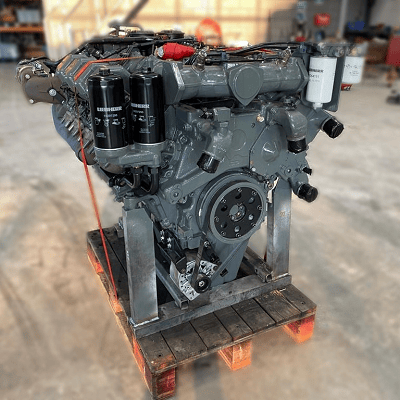The process of a dyno test on a Liebherr engine

When it comes to heavy machinery, reliability and power are paramount. Liebherr, a name synonymous with innovation and excellence in engineering, stands tall as a pioneer in the realm of heavy equipment and machinery. From towering cranes to robust excavators, Liebherr’s engineering prowess extends to the heart of these machines. We delve into the world of dyno testing a Liebherr engine, uncovering the meticulous process behind unleashing the raw power concealed within.
The foundation of excellence
Before we embark on the journey of dyno testing, it’s crucial to understand the foundation upon which Liebherr engines are built. With decades of engineering expertise and commitment to quality, Liebherr engines are crafted to withstand the most demanding environment and deliver unparalleled performance. Each component is meticulously designed and rigorously tested to ensure reliability, efficiency and longevity.
The process
1 Preparation: The engine undergoes meticulous preparation before being mounted onto the dynamo meter. This includes ensuring all connections are secure, fluids are filled to the appropriate levels, and sensors are properly calibrated.
2 Mounting: The engine is carefully mounted onto the dynamometer, a specialized device designed to simulate real-world operating conditions. Precision is paramount during this step to ensure accurate results.
3 Initial checks: Once mounted, a series of initial checks are conducted to verify proper alignment, connection integrity, and functionality of all engine systems.
4 Warm-up: The engine is started and allowed to warm up to operating temperature. This ensures consistent results and minimizes the risk of damage during testing.
5 Baseline testing: With the engine warmed up , baseline tests are conducted to establish initial performance metrics. This includes measuring power output, torque, fuel consumption, and emissions at various RPM levels.
6 Load testing: The engine is subjected to progressively increasing loads to simulate different operating conditions, such as idle, partial load and full load. This allows engineers to assess performance across the entire operating range and identify any potential issues or optimization.
7 Data analysis: Throughout the testing process, data is continuously collected and analyzed in real-time. Advanced instrumentation and software are used to monitor performance metrics and identify trends or anomalies.
8 Optimazation: Based on the data analysis, adjustments may be made to optimize engine performance. This could involve fine-tuning fuel injection timing, adjusting air-fuel ratios, or optimize turbocharger boost pressure.
9 Validation: Once testing is complete, the results are meticulously reviewed and validated against predetermined criteria and specifications. Any deviations or anomalies are thoroughly investigated to ensure accuracy and reliability.
10 Reporting: Finally, a comprehensive report is generated detailing the results of the dyno testing, including performance metrics, observations, and any recommendations for further optimization or refinement.
The outcome of dyno testing
Dyno testing a Liebherr engine is more than just a routine procedure – it’s a testament to the unwavering commitment to excellence that defines Liebherr’s engineering philosophy. By subjecting their engines to rigorous testing and analysis, Liebherr ensures that each engine delivers the uncompromising performance, reliability, and efficiency that customers expect.
In conclusion, dyno testing a Liebherr engine is not just about measuring power output. It’s about unlocking the true potential of these remarkable engines and ensuring they exceed expectations in the most challenging environments imaginable.
Garbage Can Of Injection Moulding Machine
Key Characteristics
-
High Efficiency and Productivity:
- The Garbage Can Injection Moulding Machine is capable of producing large batches of garbage cans in a short time span, ensuring high production rates.
- Its precision-engineered design ensures consistent product quality, reducing waste and rejects.
-
Flexibility and Versatility:
- The machine is equipped with the ability to adapt to different mold sizes and designs, allowing it to produce garbage cans of various sizes, shapes, and styles.
- The adjustment of process parameters, such as injection pressure and temperature, further enhances its flexibility in meeting diverse production requirements.
-
Automated Production:
- Incorporating advanced control systems and automation features, the Garbage Can Injection Moulding Machine can operate with minimal human intervention.
- This not only reduces labor costs but also ensures a safer and more reliable production process.
-
Environmentally Friendly:
- Modern garbage can injection moulding machines are designed with environmental sustainability in mind.
- They often utilize energy-efficient components and processes, as well as recyclable materials, to minimize their impact on the environment.
Key Advantages
-
Cost-Effectiveness:
- By increasing production efficiency and reducing waste, the Garbage Can Injection Moulding Machine helps manufacturers achieve significant cost savings.
- The reduced need for labor and faster production cycle times further contribute to its cost-effectiveness.
-
Improved Product Quality:
- The precision and repeatability of the injection moulding process ensure that every garbage can produced meets strict quality standards.
- This consistency in quality enhances the overall reputation and reliability of the manufacturer's products.
-
Quick Market Response:
- The flexibility and versatility of the Garbage Can Injection Moulding Machine allow manufacturers to quickly adapt to changing market demands and trends.
- They can easily modify production parameters or switch to different molds to produce new designs or sizes of garbage cans in a timely manner.
Large Injection Molding Machine,Pipe Injection Molding Machine ,custom injection molders,Garbage Can Injection Molding Machine
Ningbo Outai Plastic Machinery Technology Co.,Ltd , https://www.outacmachine.com
![<?echo $_SERVER['SERVER_NAME'];?>](/template/twentyseventeen/skin/images/header.jpg)